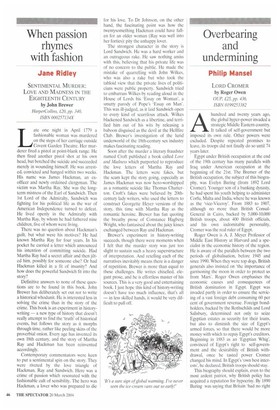When passion rhymes with fashion
Jane Ridley
SENTIMENTAL MURDER: LOVE AND MADNESS IN THE EIGHTEENTH CENTURY by John Brewer I-farperCollins, £20, pp. 340, ISBN 0002571 34X Late one night in April 1779 a fashionable woman was murdered on the steps of her carriage outside Covent Garden Theatre. Her murderer fired a pistol at point-blank range. He then fired another pistol shot at his own head, but botched the suicide and succeeded merely in wounding himself. He was arrested, convicted and hanged within two weeks. His name was James Hackman, an exofficer and newly ordained clergyman. The victim was Martha Ray. She was the longterm mistress of the Earl of Sandwich. Then 1st Lord of the Admiralty, Sandwich was fighting for his political life as the war of American Independence turned to defeat. He lived openly in the Admiralty with Martha Ray, by whom he had fathered nine children, five of whom were living.
There was no question about Hackman's guilt, but what were his motives? He had known Martha Ray for four years. In his pocket he carried a letter which announced his intention of committing suicide. Had Martha Ray had a secret affair and then jilted him, possibly for someone else? Or had Hackman killed in a fit of insanity? And how does the powerful Sandwich fit into the story?
Definitive answers to none of these questions are to be found in this book. John Brewer has deliberately set out not to write a historical whodunit. He is interested less in solving the crime than in the story of the crime. This book is an experiment in historywriting — a new type of history that doesn't really attempt to find the 'truth' of historical events, but follows the story as it morphs through time, rather like peeling skins of the proverbial onion. Every age has invented its own 18th century, and the story of Martha Ray and Hackman has been reinvented accordingly.
Contemporary commentators were keen to put a sentimental spin on the story. They were riveted by the love triangle of Hackman. Ray and Sandwich. Here was a crime of passion which resonated with the fashionable cult of sensibility. The hero was Hackman, a lover who was prepared to die for his love. To Dr Johnson, on the other hand, the fascinating point was how the twentysomething Hackman could have fallen for an older woman (Ray was well into her forties): pity the unhappy lover.
The strongest character in the story is Lord Sandwich. He was a hard worker and an outrageous rake. He saw nothing amiss with this, believing that his private life was of no concern to the public. He made the mistake of quarrelling with John Wilkes, who was also a rake but who took the tabloid view that the private lives of politicians were public property. Sandwich tried to embarrass Wilkes by reading aloud in the House of Lords his 'Essay on Woman', a smutty parody of Pope's 'Essay on Man'. This was ill-judged, as it laid Sandwich open to every kind of scurrilous attack. Wilkes blackened Sandwich as a libertine, and terrified him out of his wits by releasing a baboon disguised as the devil at the Hellfire Club. Brewer's investigation of the lurid underworld of the 18th-century sex industry makes fascinating reading.
Soon after the murder a literary fraudster named Croft published a book called Love and Madness which purported to reproduce the love letters of Martha Ray and Hackman. The letters were fakes, but the scam kept the story going, especially as James Hackman was now hero-worshipped as a romantic suicide like Thomas Chatterton. Croft's fakes were believed by 20thcentury lady writers, who used the letters to construct Georgette Heyer versions of the story, this time with Martha Ray as the romantic heroine. Brewer has fun quoting the breathy prose of Constance Hagberg Wright, who fantasised about the juicy kisses exchanged between Ray and Hackman.
Brewer's experiment in history-writing succeeds, though there were moments when I felt that the murder story was just too slight to sustain such a heavy superstructure of interpretation. And retelling each of the narratives inevitably means there is a danger of repetition. Brewer is more than equal to these challenges. He writes chiselled, elegant prose, and he is effortless master of his sources. This is a very good and entertaining book. I just hope this kind of history-writing doesn't have too much influence, that's all — in less skilled hands, it would be very difficult to pull off.


















































































 Previous page
Previous page